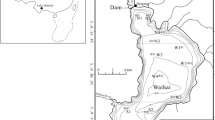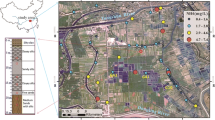Abstract
Understanding the formation mechanisms of polymeric silicates is essential to the study of microbiology and biogeochemistry. It has implications for the growth of diatoms and dinoflagellates and studying the processes that control the dissolution, precipitation, and biological uptake of different silicates species can provide an understanding of the occurrence of toxic blooms. This study examines the seasonal distribution of monomeric and polymeric silicates in the brackish and freshwater lakes of Japan. Inductively coupled plasma atomic emission spectroscopy was used to detect and quantify total dissolved silicates (TSi) and the spectrophotometric molybdenum blue method was used to detect molybdate reactive silicates (monomers to tetramers). The difference between the concentrations obtained via these two methods was used to determine the concentrations of polymeric silicates. Polymeric silicates were detected in anoxic-reducing pore waters from sediments of the freshwater Lake Biwa and Lake Kawaguchi in Japan, with a maximum concentration of 0.42 mmol L−1. Polymeric silicate was continuously detected as long as the lake bottom environments remained under anoxic-reducing conditions. It provides insights on the formation mechanisms of polymeric silicates in freshwater lakes. The polymerization of silicates is understood to occur during the adsorption reaction between monomeric silicates and Fe(OH)3 precipitate. Furthermore, this polymerization is deemed to be a dehydration condensation reaction because the silicates adsorbed on Fe(OH)3 precipitate are situated at short distances from each other. In the anoxic-reducing environments, these monomeric and polymeric silicates are released from ferric hydroxide (Fe(OH)3) precipitate by reacting with hydrogen sulfide.












Similar content being viewed by others
Data availability
The data that support the findings of this study are available from the corresponding author, JY Park, upon reasonable request.
References
Aston S (1983) Natural water and atmospheric chemistry of silicon. In: Aston S (ed) Silicon geochemistry and biogeochemistry. Academic Press, Massachusetts, US, pp 77–100
Conley D, Schelske C, Stoermer E (1993) Modification of the biogeochemical cycle of silica with eutrophication. Mar Ecol Prog Ser 101:179–192. https://doi.org/10.3354/meps101179
Cornelis JT, Delvaux B, Georg RB, Lucas Y, Ranger J, Opfergelt S (2011) Tracing the origin of dissolved silicon transferred from various soil-plant systems towards rivers: a review. Biogeosciences 8:89–112. https://doi.org/10.5194/bg-8-89-2011
Fischer WW, Knoll AH (2009) An iron shuttle for deepwater silica in Late Archean and early Paleoproterozoic iron formation. Geol Soc Am Bull 121:222–235. https://doi.org/10.1130/B26328.1
Fukusawa H, Koizumi I, Okamura M, Yasuda Y (1995) Last 2,000 year records of eolian dust concentration sea-level and precipitation changes in fine-grained sediment of Lake Suigetsu, Central Japan (in Japanese). Chigaku Zasshi 104:69–81. https://doi.org/10.5026/jgeography.104.69
Furumai H (2012) Monitoring of silicic acid and research implication (in Japanese). In: Furumai H, Sato K, Yamamoto K (eds) Silicic acid, its source and transportation (in Japanese). Gihodo Shuppan, Tokyo, Japan. 165–176
George S, Steinberg SM, Hodge V (2000) The concentration, apparent molecular weight and chemical reactivity of silica from groundwater in Southern Nevada. Chemosphere 40:57–63. https://doi.org/10.1016/s0045-6535(99)00240-4
Hansen HP, Koroleff F (1999) Determination of nutrients. In: Grasshoff K, Kremling K, Ehrhardt M (eds) Methods of seawater analysis, 3rd edn. Wiley, pp 159–228
Isshiki K, Sohrin Y, Nakayama E (1991) Form of dissolved silicon in seawater. Mar Chem 32:1–8. https://doi.org/10.1016/0304-4203(91)90021-N
Kawashima M, Hori T, Koyama M, Takamatsu T (1985) Redox cycle of manganese and iron and the circulation of phosphorus in a dredged area of the Southern lake. In: Takamatsu T (ed), Limnological and environmental studies of elements in the sediment of Lake Biwa. The National Institute for Environmental Studies, Japan, 47–62
Krauskopf K, Bird D (1995) Sedimentation and Diagenesis: Inorganic Geochemistry. In: Krauskopf K, Bird D (eds) Introduction to Geochemistry, 3rd edn. McGraw-Hill, New York, US, pp 356–384
Kusunoki K, Sakata M (2018) Analysis of historical trend of eutrophication in Lake Nakaumi, Japan, using concentrations of several index elements in sediment cores (in Japanese). Mizu Kankyo Gakkaishi 41:151–157. https://doi.org/10.2965/jswe.41.151
Kyotani T, Koshimizu S, Kobayashi H (2005) Short-term cycle of eolian dust (Kosa) recorded in Lake Kawaguchi sediments, central Japan. Atmos Environ 39:3335–3342. https://doi.org/10.1016/j.atmosenv.2005.01.026
Lacombe M, Garçon V, Comtat M, Oriol L, Sudre J, Thouron D, Le Bris N, Provost C (2007) Silicate determination in sea water Toward a reagentless electrochemical method. Mar Chem 106:489–497. https://doi.org/10.1016/j.marchem.2007.05.002
Lehtimäki M, Sinkko H, Tallberg P (2016) The role of oxygen conditions in the microbial dissolution of biogenic silica under brackish conditions. Biogeochemistry 129:355–371. https://doi.org/10.1007/s10533-016-0237
Lehtoranta J, Ekholm P, Pitkänen H (2009) Coastal eutrophication thresholds: a matter of sediment microbial processes. Ambio 38:303–308. https://doi.org/10.1579/09-A-656.1
Li X, Song J, Dai J, Yuan H, Li N, Li F, Sun S (2006) Biogenic silicate accumulation in sediments, Jiaozhou Bay. Chin J Oceanol Limnol 24:270–277. https://doi.org/10.1007/BF02842627
Maekawa K, Shirasaki K, Sawada T, Yamaguchi S, Utsunomiya T, Aoki K, Tagawa S, Isomatsu Y (1982) Study on the eutrophication of Lakes Mikata Goko: Horizontal distribution of water quality of the lakes (in Japanese). Annual Report of The Environmental Pollution Research Center of Fukui Prefecture, Japan, 181–185
Nagasaka M, Yoshizawa K, Ariizumi K, Hirabayashi K (2002) Temporal changes and vertical distribution of macrophytes in Lake Kawaguchi. Limnology 3:107–114. https://doi.org/10.1007/s102010200012
Nalewajko C, Murphy T (2001) Effects of temperature, and availability of nitrogen and phosphorus on the abundance of Anabaena and Microcystis in Lake Biwa, Japan: an experimental approach. Limnology 2:45–48. https://doi.org/10.1007/s102010170015
Ning R (2002) Discussion of silica speciation, fouling, control and maximum reduction. Desalination 151:67–73. https://doi.org/10.1016/S0011-9164(02)00973-6
O’Connor T (1961) The reaction rates of polysilicic acids with molybdic acid. J Phys Chem 65:1–5. https://doi.org/10.1021/j100819a001
Park JY, Sugahara S, Egawa M, Seike Y (2020) Mechanism of silicate elution by hydrogen sulfide from bottom sediment in a brackish lake. Limnology 21:197–205. https://doi.org/10.1007/s10201-019-00601-2
Park JY, Sugiyama M (2018) Formation and decomposition of polymeric silicate in pore water, 17th World Lake Conference proceedings, Lake Kasumigaura, Ibaraki, Japan, 1159–1161
Perry C, Keeling-Tucker T (2000) Biosilicification: the role of the organic matrix in structure control. J Biol Inorg Chem 5:537–550. https://doi.org/10.1007/s007750000130
Pollingher U (1990) Effects of latitude on phytoplankton composition and abundance in large lakes. In: Tilzer M, Serruya C (eds) Large lakes: ecological structure and function. Springer, Berlin, Germany, pp 368–402
Schelske C, Stoermer E (1971) Eutrophication, silica depletion, and predicted changes in algal quality in Lake Michigan. Science 173:423–424. https://doi.org/10.1126/science.173.3995.423
Sjöberg S (1996) Silica in aqueous environment. J Non-Cryst Solids 196:51–57. https://doi.org/10.1016/0022-3093(95)00562-5
Sugahara S, Yurimoto T, Ayukawa K, Kimoto K, Senga Y, Okumura M, Seike Y (2010) A simple in situ extraction method for dissolved sulfide in sandy mud sediments followed by spectrophotometric determination and its application to the bottom sediment at the Northeast of Ariake Bay (in Japanese). Bunseki Kagaku 59:1155–1161. https://doi.org/10.2116/bunsekikagaku.59.1155
Swedlund PJ, Webster JG (1999) Adsorption and polymerisation of silicic acid on ferrihydrite, and its effect on arsenic adsorption. Water Res 33:3413–3422. https://doi.org/10.1016/S0043-1354(99)00055-X
Tallberg P (2000) Silicon and its impacts on phosphorus in eutrophic freshwater lakes. Ph. D. thesis. Univ of Helsinki
Tanaka M (1992) The Lakes in Japan (in Japanese). Nagoya University, Japan
Tanaka M, Takahashi K, Nemoto M, Horimoto N (2013) Selectivity of silica species in ocean observed from seasonal and local changes. Spectrochim Acta, Part A 104:423–427. https://doi.org/10.1016/j.saa.2012.11.040
Tarutani T (1989) Polymerization of silicic acid a review. Anal Sci 5:245–252. https://doi.org/10.2116/analsci.5.245
Terashima A, Ueda T (1982) Effect of bottom dredging on some environmental factors and benthic animals in the South basin of Lake Biwa (in Japanese). Jpn J Limnol 43:81–87. https://doi.org/10.3739/rikusui.43.81
Tréguer P, Nelson D, Van Bennekom A, de Master D, Leynaert A, Quéguiner B (1995) The silica balance in the world ocean: a reestimate. Science 268:375–379. https://doi.org/10.1126/science.268.5209.375
Valdes LM, Price KS, Luther GW III (2002) Iron sulfur phosphorus cycling in the sediments of a shallow coastal bay: implications for sediment nutrient release and benthic macroalgal blooms. Limnol Oceanogr 47:1346–1354. https://doi.org/10.4319/lo.2002.47.5.1346
Wang D (2008) Neurotoxins from marine dinoflagellates: a brief review. Mar Drugs 6:349–371. https://doi.org/10.3390/md20080016
Van der Weijden C (2007) Silica I: silicon analytical, physical and terrestrial geochemistry, Ph. D. thesis. Utrecht University
Willén E (1991) Planktonic diatoms - an ecological review. Archiv für Hydrobiologie. Supplementband, Algological studies 62: 69–106. ISSN 0342–1120
Yamamoto S, Nakamura T, Uchiyama T (2017) Newly discovered lake bottom springs from Lake Kawaguchi, the Northern foot of Mount Fuji Japan. J Jap Assoc Hydrol Sci 47:49–59. https://doi.org/10.4145/jahs.47.49
Yee N, Phoenix V, Konhauser K, Benning L, Ferris G (2003) The effect of cyanobacteria on silica precipitation at neutral pH: implications for bacterial silicification in geothermal hot springs. Chem Geol 199:83–90. https://doi.org/10.1016/S0009-2541(03)00120-7
Zuhl RW, Amjad Z (2013) Solution chemistry impact on silica polymerization by inhibitors. In: Amjad Z (ed) Mineral Scales in Biological and Industrial Systems. CRC Press, Florida, US, pp 173–200
Acknowledgements
We thank the Center for Ecological Research, Kyoto University for the use of their research vessel "Hasu" and observation facilities. We thank Dr. Y. Goda, Dr. T. Akatsuka, and Prof. S. Nakano of the Center for Assistance for support during field work. This work was partly supported by JSPS KAKENHI vide Grant Number: 17K00518.
Author information
Authors and Affiliations
Corresponding author
Additional information
Handling Editor: Yuko Sugiyama.
Publisher's Note
Springer Nature remains neutral with regard to jurisdictional claims in published maps and institutional affiliations.
Rights and permissions
Springer Nature or its licensor (e.g. a society or other partner) holds exclusive rights to this article under a publishing agreement with the author(s) or other rightsholder(s); author self-archiving of the accepted manuscript version of this article is solely governed by the terms of such publishing agreement and applicable law.
About this article
Cite this article
Park, J.Y., Sugiyama, M., Sugahara, S. et al. Detection of polymeric silicate in the pore water of freshwater lakes. Limnology 24, 171–179 (2023). https://doi.org/10.1007/s10201-023-00716-7
Received:
Accepted:
Published:
Issue Date:
DOI: https://doi.org/10.1007/s10201-023-00716-7




